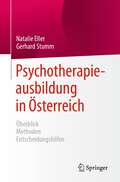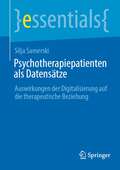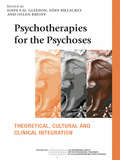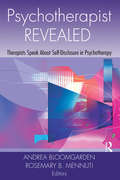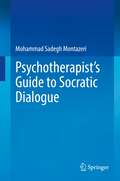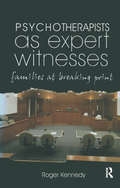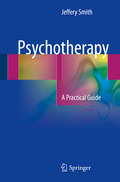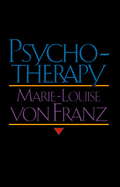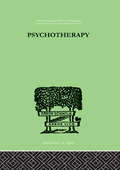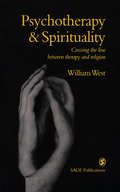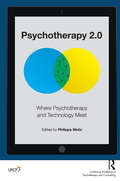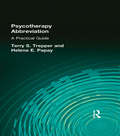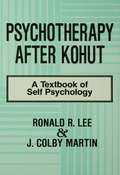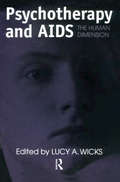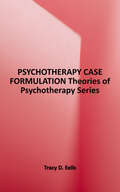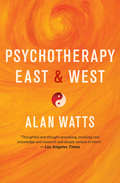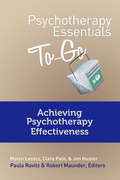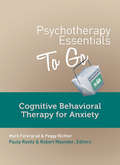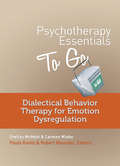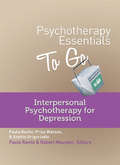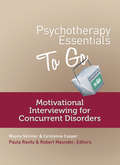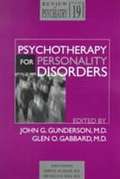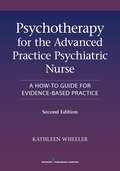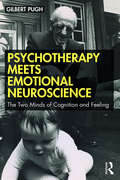- Table View
- List View
Psychotherapieausbildung in Österreich: Überblick Methoden Entscheidungshilfen
by Gerhard Stumm Natalie EllerDieses Buch bietet eine Orientierungshilfe für den Ausbildungsweg zur Psychotherapeut:in, der in Österreich mehrstufig angelegt ist. Nach einem methodenübergreifenden ersten Abschnitt folgt die langjährige Fachausbildung, für die rund 20 anerkannte Psychotherapiemethoden und über 40 Ausbildungseinrichtungen zur Auswahl stehen.Die Methoden und Ausbildungsangebote sind - differenziert nach psychodynamischen, humanistischen, systemischen und verhaltenstherapeutischen Ansätzen - kompakt nach einem einheitlichen Raster dargestellt. Dies ermöglicht einen Vergleich der inhaltlichen Ausrichtung der verschiedenen Methoden sowie der Schwerpunktsetzung, Dauer und Kosten der einzelnen Ausbildungswege.Das Kompendium liefert darüber hinaus wertvolle Informationen und Tipps zur Ausbildungssituation, zu den gesetzlichen Grundlagen, zu den Berufsaussichten, zur Akademisierung und zur zukünftigen Gestaltung des Ausbildungsangebots in Österreich.Es bietet somit eine praktische Entscheidungshilfe und unterstützt Interessent:innen und Psychotherapeut:innen in Ausbildung in Österreich in Hinblick auf ihren Ausbildungsweg.
Psychotherapiepatienten als Datensätze: Auswirkungen der Digitalisierung auf die therapeutische Beziehung (essentials)
by Silja SamerskiIm Feld der Psychotherapie ist die Begegnung zwischen zwei Menschen nicht mehr selbstverständlich. Online-Sitzungen sind alltäglich geworden. Apps bieten Therapien ohne Therapeuten und simulieren ein verständnisvolles Gegenüber. Dieses essential untersucht, wie die Digitalisierung unsere grundlegenden Selbstverständlichkeiten derart verändert, dass es kaum noch befremdlich erscheint, sich von Software trösten und therapieren zu lassen. Es plädiert für „digitale Askese“, um das Bewusstsein für den fundamentalen Unterschied zwischen programmierter Kommunikation und persönlichen Begegnung zu bewahren.
Psychotherapies for the Psychoses: Theoretical, Cultural and Clinical Integration (The International Society for Psychological and Social Approaches to Psychosis Book Series)
by John F. M. Gleeson Eóin Killackey Helen KrstevCan biological and psychological interventions be integrated in the treatment of psychosis? Throughout the world, access to psychotherapeutic and psychosocial treatments for the psychoses varies significantly, with many people diagnosed with psychotic disorders receiving only medication as treatment. Psychotherapies for the Psychoses considers ways that this gap can be bridged through theoretical, cultural and clinical integration. The theme of integration offers possibilities for trainees and experienced mental health professionals from diverse orientations and cultural perspectives to strengthen alliances for tackling the gap in availability of treatments. In this volume contributors discuss: Theoretical integration across the psychological therapies for psychoses Global perspectives on psychosocial approaches for psychoses Integrating psychotherapeutic thinking and practice into 'real world' settings. Psychotherapies for the Psychoses explores different approaches from a variety of theoretical perspectives, providing significant encouragement for mental health practitioners to broaden the range of humane psychotherapeutic possibilities for people suffering from the effects of psychosis.
Psychotherapist Revealed: Therapists Speak About Self-Disclosure in Psychotherapy
by Rosemary B. Mennuti Andrea BloomgardenIn this edited volume, the real dialogue begins. Therapists speak openly and honestly about their self-disclosure practices, decisions and clinical dilemmas. Bloomgarden and Mennuti bring together research, training and tales from their clinical experience to illuminate lessons derived from their own journeys toward judicious, balanced self-disclosure practices. In a readable fashion, the stories highlight a variety of self-disclosure and boundary issues that occur in the course of psychotherapy. Numerous treatment modalities and clinical orientations are represented. The collective wisdom offered through these stories, which includes suggested guidelines and a standard of care for good practice, will assist the reader in developing a better understanding of what it means to self-disclose appropriately, recognizing a flexible middle ground between "too much" and "too little" along with responsiveness to client need. The Freudian based taboo that rigidly warns against all self-disclosure is antiquated, and a more reasonable, balanced perspective is under way. As a psychotherapeutic community, including psychologists, social workers, art therapists, counselors, dance/movement therapists who are all represented in this book, it is time to talk openly about a balanced, judicious, and therapeutically appropriate approach to self-disclosure and boundaries. Bravely, that is exactly what the authors in this book have done.
Psychotherapist's Guide to Socratic Dialogue
by Mohammad Sadegh MontazeriThis concise volume serves as a ready guide to using Socratic dialogue with psychotherapy clients. In very clear language, this volume takes the reader through a working definition of the Socratic method and its clinical application. Used often in cognitive-behavioral therapy, this method is useful to all modes of psychotherapy. This guide provides a solid background to understanding Socratic questioning and examines the various types of questions that may be employed, as well as the different levels that may apply. Theory and explication are bolstered by numerous clinical examples. Useful for both beginning and experienced therapists, this book will enhance the therapeutic relationship and contribute effectively to better outcomes.
Psychotherapists as Expert Witnesses: Families at Breaking Point
by Roger KennedyThe book describes the author's extensive experience of working as an expert witness in family courts. It provides detailed guidance for assessing families for the courts, as well giving many detailed clinical examples to illustrate points made. Topics covered include guidance for experts, assessment of families, contact issues, fostering and adoption and rehabilitation issues.
Psychotherapy
by Jeffery SmithThis title combines the many schools of thought on psychotherapy into one reader-friendly guide that coaches psychotherapists through the various techniques needed as the field expands. Unlike any other book on the market, this text considers all of the simultaneous advances in the field, including the neurobiology of emotions, the importance of the therapeutic relationship, mindfulness meditation, and the role of the body in healing. Written with genuine respect for all traditions from CBT to psychodynamics, the book unifies views of psychopathology and cure based on the notion of the mind-brain as an organ of affect regulation. The book accounts for the tasks that characterize psychotherapist activity in all therapies, how they are performed, and how they result in therapeutic change. The book also reviews the various pathologies seen in general practice and guides the reader to the specific therapist-patient interactions needed for their resolution. With its big-picture focus on clinical practice, Psychotherapy: A Practical Guide is a concise resource for students, psychotherapists, psychologists, residents, and all who seek to integrate what is new in psychotherapy.
Psychotherapy
by Marie-Louise von Franz"In twelve essays--eight of which appear here in English for the first time--the internationally known analyst Marie-Louise von Franz explores important aspects of psychotherapy from a Jungian perspective. She draws on her many years of practical experience in psychotherapy, her intimate knowledge of Jung's methods and theories, and her wide-ranging interests in fields such as mythology, alchemy, science, and religion to illumine these varied topics: * Projection * Transference * Dream interpretation * Self-realization * Group psychology * Personality types * Active imagination * The therapeutic use of hallucinogenic drugs * The choice of psychotherapy as a profession * The role of religious experience in psychological healing " Marie-Louise von Franz (1915-1998) was the foremost student of C. G. Jung, with whom she worked closely from 1934 until his death in 1961. A founder of the C. G. Jung Institute of Zurich, she published widely on subjects including alchemy, dreams, fairy tales, personality types, and psychotherapy.
Psychotherapy
by Schilder, PaulFirst published in 1999. Routledge is an imprint of Taylor & Francis, an informa company.
Psychotherapy & Spirituality: Crossing the Line between Therapy and Religion (Perspectives on Psychotherapy series)
by Dr William West`There have been many books written about counselling with respect to class, politics, gender, culture and similar issues but, as far as I am aware , this is the first major work to be presented in this country about working with a client's spirituality and the importance this may have.... Is a must for trainees in the field and for those who feel a client's spirituality is an irrelevance'- Cahoots `This is a textbook covering all aspects of this subject, eg there is a chapter on "why therapists need training in dealing with spiritual issues" and another on "the meeting place and the differences between spiritual direction and therapy". I recommend this book to practitioners in this field' - Retreats This thoughtful and intelligent book encourages psychotherapists and counsellors to consider seriously the relationship between spiritual experiences and therapeutic practice. It proposes that therapy itself can be seen as a spiritual process and discusses the implications of this view for therapists, clients and the wider world. Examining the relationship between spirituality and the main schools of therapy, William West distinguishes clearly between spiritual direction and specific therapies. He offers practical advice to help practitioners increase their awareness of spiritual issues, and guidance on the use of spiritual interventions within therapy.
Psychotherapy 2.0: Where Psychotherapy and Technology Meet (United Kingdom Council For Psychotherapy Ser.)
by Philippa WeitzThe digital age is both exciting and challenging for psychotherapy, opening the door to clients groups previously not able to access psychological help, whilst also providing the challenges caused by social media and internet abuse and how these impact on the consulting room. Psychotherapy 2.0 blows open the consulting room doors and shows successful pathways for attracting new clients to gain access to psychological help, as well as demonstrating that despite initial scepticism, working online as a psychotherapist or counsellor can be as effective as 'face2face' work: the therapeutic relationship may be different but it remains the centrally important feature for successful psychotherapy. It follows therefore that all psychotherapists and counsellors need to be fully informed about the impact of the digital age on their clinical practice. Psychotherapy 2.0 covers the key issues for psychotherapists and counsellors who are, or are thinking of, working online, include thinking about psychotherapy in the digital age, the requirements to modify training both for working online and also the digital issues as they arise within the face2face consulting room.
Psychotherapy Abbreviation: A Practical Guide
by Terry S Trepper Helena E PapayPsychotherapy Abbreviation is a field-tested approach designed to train both experienced and student mental health professionals to do brief therapy that is effective and highly satisfactory to clients. This book is unique in that it is the only text that is compatible with almost all approaches to treatment, making it suitable as a primer of brief therapy usable by virtually all psychotherapists. Most other brief therapy books are affiliated with a specific theory of psychopathology, making each limited to those who share the author's theoretical orientation.Pekarik wrote this text based on his own brief therapy training manual because he could not find a text suitable for the wide range of psychotherapy approaches represented by the therapists whom he trains in his research, teaching, and consulting work. By offering a unique approach derived from the “active ingredients” common to all forms of brief therapy and the literature on client treatment preferences, Psychotherapy Abbreviation simplifies the abbreviation process and makes it accessible to all therapists. Pekarik's strategies have been field-tested; he has used them to train hundreds of therapists who have demonstrated success with clients--increased client satisfaction, improved treatment effectiveness, and lowered dropout rates. These same therapists also doubled the proportion of cases they treated with brief therapy.This “how to do it” text is extremely practical. It assumes that the reader already has a theory and set of therapy techniques, true of even most graduate students. The emphasis is then placed on the treatment abbreviation process itself. Because of this highly focused approach, the text will, like the technique it describes, be concise and brief. By avoiding association with any particular school of therapy, Pekarik's approach is usable by all schools of therapy. Therapists and future therapists now in graduate school will benefit from Psychotherapy Abbreviation as it explores these topics:rationale for the abbreviation of psychotherapypractical and ethical issues to consider in client selectiona conceptual model for treatment abbreviationrapid assessment and case conceptualizationestablishing a brief therapy focusgoal establishment and negotiationadapting standard psychotherapy techniques to the brief formatpractice issues in brief therapyPsychotherapy Abbreviation is two-part. Part one is an orientation to this model of brief therapy in which Pekarik emphasizes a research-based rationale for doing brief therapy; presents a general theory of why brief treatments work; and provides guidelines for the identification of appropriate clients for brief therapy.The second part of the text is devoted to technical skills training. It begins with an overview of the techniques common to most schools of brief therapy and describes a “universal model” of brief therapy. Readers are then taken step-by-step through a description of the four most important abbreviation techniques, presented in the typical order of use with clients. To encourage readers to consistently apply the recommended techniques, Pekarik includes one particular training case which he describes in detail and uses it in all of the technical skills chapters in special “Case Application” sections of these chapters. Before describing the detailed applications, Pekarik prompts readers to consider how they would apply the abbreviating technique presented in that chapter to the case. With individual exercises, he gives special attention to how readers can adapt their personal therapy styles and theoretical orientations to brief therapy. As a result, readers develop both a rationale and abbreviation strategy compatible with their values and practical needs as therapists. The exercises are found in each chapter in special “exercise
Psychotherapy After Kohut: A Textbook of Self Psychology
by Ronald R. Lee J. Colby MartinHailed as "a superb textbook aimed at introducing psychoanalytic self psychology to students of psychotherapy" (Robert D. Stolorow), Psychotherapy After Kohut is unique in its grasp of the theoretical, clinical, and historical grounds of the emergence of this new psychotherapy paradigm. Lee and Martin acknowledge self psychology's roots in Freud's pioneering clinical discoveries and go on to document its specific indebtedness to the work of Sandor Ferenczi and British object relations theory. Proceeding to readable, scholarly expositions of the principal concepts introduced by Heinz Kohut, the founder of self psychology, they skillfully explore the further blossoming of the paradigm in the decade following Kohut's death. In tracing the trajectory of self psychology after Kohut, Lee and Martin pay special attention to the impact of contemporary infancy research, intersubjectivity theory, and recent empirical and clinical findings about affect development and the meaning and treatment of trauma.
Psychotherapy And AIDS: The Human Dimension
by Lucy A. WicksFirst published in 1997. Routledge is an imprint of Taylor & Francis, an informa company.
Psychotherapy Case Formulation
by Tracy D. EellsThis concise and engaging primer helps beginning therapists systematically organize their thoughts and ideas about a client, using an evidence-based approach to case formulation. Formulating cases is an essential component of psychotherapy training and practice. Yet beginning therapists often struggle to organize their ideas about the client and apply theory to the case. This book is based on the author's extensive experience teaching case formulation to graduate students. It describes a highly adaptable and evidence-based framework for conceptualizing clients and planning treatment. Applicable to both simple and complex cases, the model can be used regardless of one's theoretical orientation. Readers are introduced to basic concepts that include the benefits of case formulation, sound decision-making, and the importance of cultural considerations, and then are led step-by-step through the action-oriented components of the model. This book is an indispensable aid for novice and experienced therapists seeking to develop and improve upon this core competency.
Psychotherapy East & West
by Alan WattsBefore he became a counterculture hero, Alan Watts was known as an incisive scholar of Eastern and Western psychology and philosophy. In this 1961 classic, Watts demonstrates his deep understanding of both Western psychotherapy and the Eastern spiritual philosophies of Buddhism, Taoism, Vedanta, and Yoga. He examined the problem of humans in a seemingly hostile universe in ways that questioned the social norms and illusions that bind and constrict modern humans. Marking a groundbreaking synthesis, Watts asserted that the powerful insights of Freud and Jung, which had, indeed, brought psychiatry close to the edge of liberation, could, if melded with the hitherto secret wisdom of the Eastern traditions, free people from their battles with the self. When psychotherapy merely helps us adjust to social norms, Watts argued, it falls short of true liberation, while Eastern philosophy seeks our natural relation to the cosmos.
Psychotherapy Essentials To Go: Achieving Psychotherapy Effectiveness
by Molyn Leszcz Clare Pain Robert Maunder Paula Ravitz Jon HunterA quick-reference, multi-media guide to practical psychotherapy skills that improve client outcomes. Rigorously field-tested by on-the-ground clinicians, these practical guidebooks--sold separately or as a set--provide easy-to-use, evidence-based summaries of five core therapy techniques. Filled with self-test questionnaires, case studies, diagrams, exercises and role play transcripts, they are ideal teaching and learning resources. Accompanying each guide is a DVD featuring an hour-long video of sample therapy sessions and clinical explications, as well as a handy pocket-reminder card that summarizes key information about the therapy technique. An on-the-go package of essential tools that busy clinicians won't want to be without. The final book in the Psychotherapy Essentials to Go series, this hands-on guide, with accompanying DVD of sample therapy sessions, answers the question: What makes a therapist effective? Several evidence-based strategies are presented to improve outcomes. Maintaining a therapeutic alliance and reducing impasses by understanding relational dynamics, attachment, trauma, and countertransference are all emphasized as helpful aspects of a clinician's repertoire in challenging treatment situations.
Psychotherapy Essentials to Go: Cognitive Behavioral Therapy for Anxiety
by Robert Maunder Paula Ravitz Mark Fefergrad Peggy RichterA quick-reference, multi-media guide to using cognitive behavioral therapy (CBT) to treat anxiety. From fundamental skills to more detailed clinical application across a number of different anxiety disorders--including panic, social anxiety, generalized anxiety, OCD, and specific phobias--this concise guide provides a user-friendly overview of CBT for anxiety so any clinician can begin to implement it with their patients. Techniques for early, middle, and end phases of treatment are covered, including goal-setting and collaborative therapeutic engagement with clients, as well as methods for interoceptive exposure, challenging avoidance, and employing the thought record. Included in this comprehensive guide are a DVD of sample therapy sessions and clinical explication that describe how to implement the protocol, as well as a laminated pocket reminder card. An on-the-go package of practical tools that busy clinicians won't want to be without. Please note that the ebook version of this title does not include the DVD.
Psychotherapy Essentials to Go: Cognitive Behavioral Therapy for Depression
by Robert Maunder Paula Ravitz Mark Fefergrad Ari ZaretskyA quick-reference, multi-media guide to using cognitive behavioral therapy (CBT) to treat depression. A widely researched protocol for treating major depressive disorder, Cognitive Behavioral Therapy (CBT) helps clients feel better and cope more effectively by teaching them essential skills to become their own therapists. This guide explains the basic cognitive model, the therapeutic stance, and some of the most important cognitive and behavioral interventions for depression, equipping clinicians with all the key information they need to begin treatment. Core strategies covered include how to nurture the therapeutic rapport, focusing on the "here and now", goal-setting, and behavioral activation techniques such as activity monitoring, the thought record, and behavioral experiments. An invaluable overview of techniques to challenge clients' negative automatic thoughts and depressive behaviors in order to promote immediate and durable change. Included in this comprehensive guide are a DVD of sample therapy sessions and clinical explication that describe how to implement the protocol, as well as a laminated pocket reminder card. An on-the-go package of practical tools that busy clinicians won't want to be without. Please note that the ebook version of this title does not include the DVD.
Psychotherapy Essentials to Go: Dialectical Behavior Therapy for Emotion Dysregulation
by Robert Maunder Paula Ravitz Shelley Mcmain Carmen WiebeA quick-reference, multi-media guide to using dialectical behavior therapy (DBT) to treat affect dysregulation. Developed by Marsha Linehan, PhD, Dialectical Behavior Therapy (DBT) is an evidence-based treatment for borderline personality disorder that integrates principles of change and acceptance in order to help clients who have severe emotion dysregulation and impulsive behavior. This guide describes the primary tenets of DBT and illustrates some of its essential techniques--namely validation, commitment strategies, behavioral chain analysis, and skills coaching--that can be used with a range of clients. By understanding underlying problems and balancing compassionate acceptance with a push for change, clinicians can use DBT basics in their day-to-day work to help clients manage emotion dysregulation and impulsive urges. Included in this comprehensive guide are a DVD of sample therapy sessions and clinical explication that describe how to implement the protocol, as well as a laminated pocket reminder card. An on-the-go package of practical tools that busy clinicians won't want to be without.
Psychotherapy Essentials to Go: Interpersonal Psychotherapy for Depression
by Robert Maunder Paula Ravitz Sophie Grigoriadis Priya WatsonA quick-reference, multi-media guide to using interpersonal psychotherapy (IPT) to treat depression. Interpersonal Psychotherapy (IPT) is an evidence-supported, short-term therapy that focuses on universal life problems involving change, loss, and conflict in relationships, particularly when these problems relate to depression. At its heart is an emphasis on relationships as a healing force during stressful life events. This guide walks readers through the core principles of IPT treatment--how to consider underlying psychological and biological factors that may predispose a client to depression, including insecure attachment; how to effectively communicate with clients to improve their relationship problems; and how to conduct "interpersonal inventories" to help clients connect to a support system that may be helpful in their recovery process. Included in this comprehensive guide are a DVD of sample therapy sessions and clinical explication that describe how to implement the protocol, as well as a laminated pocket reminder card. An on-the-go package of practical tools that busy clinicians won't want to be without. Please note that the ebook version of this title does not include the DVD.
Psychotherapy Essentials to Go: Motivational Interviewing for Concurrent Disorders
by Robert Maunder Paula Ravitz Carolynne Cooper Wayne SkinnerA quick-reference, multi-media guide to using Motivational Interviewing (MI) to treat co-occurring disorders. Addiction--whether to alcohol and drugs, sex, gambling, or Internet use--and mental health problems often go hand-in-hand. This concise book summarizes the key principles of a particular therapeutic approach to concurrent disorders, Motivational Interviewing (MI), which guides clients in eliciting and strengthening their desire for change. Laying out a four-stage treatment model--engagement, preparation, active treatment, and continuing care--the book walks readers through key facets of the therapeutic rapport at the heart of MI: working collaboratively on goals; connecting to the patient by understanding his or her strengths, needs, and concerns; and using the core MI skills of open questions, affirmations, reflections, and summaries ("OARS"). Readers are immersed in the spirit of MI through explanations and illustrations, preparing them for the practical challenges of therapeutic work with clients who suffer from addiction and mental health problems. Included in this comprehensive guide are a DVD of sample therapy sessions and clinical explication that describe how to implement the protocol, as well as a laminated pocket reminder card. An on-the-go package of practical tools that busy clinicians won't want to be without. Please note that the ebook version of this title does not include the DVD.
Psychotherapy For Personality Disorders
by Glen O. Gabbard John G. GundersonDefined by stable, long-term, subjective distress and/or social impairment, personality disorders affect up to 18% of the population. Social impairment and health care usage are far more prevalent among people with personality disorders than among people with major depressive disorders. Personality disorders are highly prevalent, variable, and notoriously difficult to treat, and they continue to challenge the therapeutic community and represent a formidable public health concern. This volume ably addresses personality disorders as one of the top priorities of psychiatry for the new millennium, offering a thorough and updated review and analysis of empirical work to point up the issues central to developing a therapeutic model for treatment as well as current research challenges. A review of extant research yields the heartening conclusion that psychotherapy remains an effective treatment for people with personality disorders. An examination of psychodynamic treatment for borderline personality disorder speaks to its efficacy. An analysis of the rationale for combining psychotherapy and psychopharmacology emphasizes the importance of identifying temperament and target conditions. A well-documented and reasoned treatise on antisocial personality disorder makes the crucial point that clinicians must acquire a depth of understanding and skill sufficient to determine what the cut-off point is for treatable versus nontreatable gradations. With the caveat that evidence supporting the efficacy of cognitive treatments for personality disorders is slight and that such approaches require tailoring, a strong case is made for their validity. This timely volume both answers and reframes many stubborn questions about the efficacy of psychotherapy for treating personality disorders.
Psychotherapy For The Advanced Practice Psychiatric Nurse: A How-To Guide For Evidence-Based Practice (Second Edition)
by Kathleen WheelerThis is a how-to compendium of evidence-based approaches to practicing psychotherapy for both the experienced and neophyte advanced practice psychiatric nurse. This book integrates neuroscience with relationship science and unites disparate psychotherapeutic approaches into a model that is concise and straightforward, yet sufficiently comprehensive to provide a framework for practice. <P><P>The most useful therapeutic models are highlighted with principles, and techniques of treatment for nurse psychotherapists and those with prescriptive authority. This second edition expands the award-winning first edition, providing guidelines, forms, and case studies to assist APPNs in deciding which treatment to use based on psychotherapy outcome studies and practice guidelines.
Psychotherapy Meets Emotional Neuroscience: The Two Minds of Cognition and Feeling
by Gilbert PughPsychotherapy Meets Emotional Neuroscience: The Two Minds of Cognition and Feeling introduces new insights from the neurosciences into the nature of our emotions and feelings, and argues for a more empathetic approach to psychotherapy as a result. Respectful of Freud the neurologist and explorer of the mind, the book seeks to contextualise psychoanalytic theory with recent discoveries in how emotions are generated in the brain, as well as those around memory, to clarify key psychological processes such as projection and transference. It includes sketches of a number of influential analysts whose emphasis has been on a close, affective relationship with their patients—including Ferenczi, Kohut and Winnicott—and explains why, in the light of recent research, empathy is necessary for any effective psychotherapeutic relationship. There are also chapters on the use of drugs to complement psychotherapy, and how the free energy principle can explain brain functioning. In an era when neuroscientific research has provided far-reaching discoveries into how our brains work, this clear-sighted, accessible overview will offer psychotherapists and psychoanalysts, whether practicing or training, or indeed non-professionals seeking therapy for personal reasons, a way of incorporating new knowledge into their understanding of their patients and themselves.
